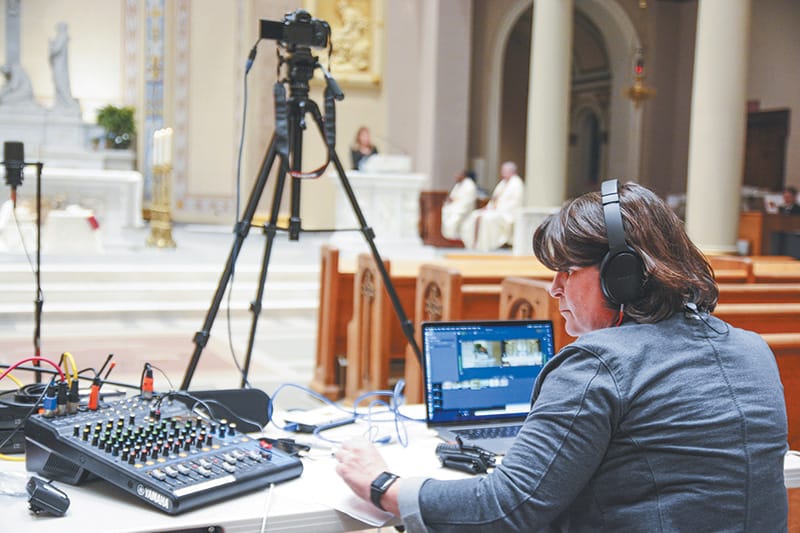
With large gatherings of people and the public celebration of Mass blocked by the COVID-19 pandemic, the Diocese of Nashville shared its observance of Holy Week on a variety of electronic platforms.
The number of viewers who watched all or part of the liturgies, which were pared down under the guidance of the Vatican, far exceeded the number of people who would have been able to see them live.
The diocese livestreamed Bishop J. Mark Spalding celebrating Mass for Holy Thursday and the Easter Vigil, and leading the service for the Veneration of the Cross on Good Friday on its website and Facebook page. On Easter Sunday, Bishop Spalding’s Mass from the Cathedral of the Incarnation was broadcast on WZTV Fox 17.
The overnight rating for the Easter Sunday Mass, according to Fox 17, showed 58,991 people were watching, far outstripping the typical number of viewers for paid programming in the same time slot at 11 a.m., which is 2,000 to 5,000.
On Fox 17’s Facebook page, the Easter Sunday Mass had 21,000 views, 405 likes/loves, 169 shares and 139 comments.
The Easter Sunday Mass also was shown on the diocese’s website and Facebook page, where it had 5,600 views, 231 likes/loves, 26 shares and 13 comments.
The other Holy Week services and Easter Vigil Mass received about 15,000 views on the diocese’s social media and website postings.
All of the Holy Week and Easter Masses and services can be viewed at www.watchmass.com.
“I think we did it as well as we could,” Bishop Spalding said. “We use the gifts God has given us.”
“The numbers are very good,” said Father Austin Gilstrap, the director of vocations for the diocese, who helped organize the recording of the various services. “A lot more people saw the bishop during Holy Week this year than would have if we were doing it live” and in person.
“I think a lot of people really did appreciate the efforts we made,” Father Gilstrap said. “The people of God in the Diocese of Nashville and around the world are really suffering because they can’t go to Mass. We know that while we couldn’t fix that … we could at least try to offer them an opportunity to worship.
“While it wasn’t the same … it was at least an opportunity for people to turn on their computer and turn on their television and worship God,” he said of the digital presentations of the Masses.
All of the Masses and services took place at the Cathedral of the Incarnation in Nashville without a congregation.
Angie Bosio, Jayce Boynton and Joan Watson, the diocesan director of faith formation, who regularly produce the “Three Minute Theology” video series, produced the Triduum Masses and services, and KGV studios, which has produced several videos for the Vocations Office, produced the broadcast of the Easter Sunday Mass.
“It was a very surreal experience for me as a priest,” Father Gilstrap said. “I was in a sense a translator for the video people and the tech people and the ministers for Holy Week.”
“We wanted to make sure we have a unified vision” for all the videos, Father Gilstrap said, “and what it meant to have the right shot.”
Father Gilstrap and others working on the production created a “shot book” with detailed instruction for each camera shot during all of the Masses and services.
“I had both really holy conversations about what was going on in Holy Week and very odd conversations about how to get the right incense shot,” he said.
For Bishop Spalding, celebrating Mass before an empty church has been a new experience.
“The key word for this situation is surreal,” Bishop Spalding said. “It’s not easy preaching and presiding to a basically empty church.”
“Any good preacher will tell you, you draw energy from the people. Without them, you have to work twice as hard,” he said.
“You have to put in your mind a congregation, and put in your mind that memory,” he said.
The diocese was looking for ways to connect to the community when it decided to approach the local television stations about broadcasting the Easter Sunday Mass, Bishop Spalding said. “We started dreaming of things to do outside the box in this situation we found ourselves in.”
“It was a great opportunity for us to reach out to the wider community,” including non-Catholics who might not be familiar with the Catholic Church or a Catholic Mass, Bishop Spalding said.
To help people understand what was happening during the Mass, Father Rhodes Bolster provided commentary, similar to the approach used by the Vatican when it broadcasts Masses by the pope.
The message of his homily for the Easter Mass, Bishop Spalding, was “the core teaching of our Christian faith: Christ, by the total gift of himself to the father, has been raised and conquered sin, darkness and death. And he is risen.”
In his homily, Bishop Spalding urged people to proclaim the good news of Christ’s resurrection to those who need his mercy.
When Jesus gave his great commission to his disciples, Bishop Spalding said, it was “not only to serve, but to proclaim.”
“Just as the Lord lifts us up, we look out into the world and we see the others, we see others who need the good news,” he said. “We take it to the margins. We take it to those having troubles and trials.”
“We know what mercy is,” Bishop Spalding said, “and as we receive mercy from God, we share it with others.”
“In these moments I ask you to ponder how you are proclaiming the good news of Jesus Christ,” Bishop Spalding said. “What are you doing to show the world that Christ is risen. … Do something that shows the world that you believe that Jesus Christ is risen. That you cling to him, and in that you have victory.”









